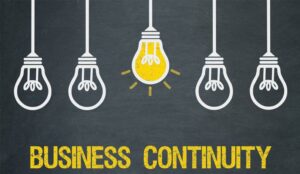CallMiner discuss their approach to business continuity during these difficult times.
In recent weeks many of us have been focused on executing our business continuity plan, moving to a remote workforce, and supporting our employees’ physical and emotional well-being.
As we carried out our plan we thought it might be useful to share with you some of what we’ve done to potentially provide you with ideas that might help in the execution of your plan.
First, We Had a Business Continuity Plan (BCP) (and Acted Early)
Perhaps lucky to some extent, with our largest office in Southwest Florida, we’ve necessarily had a BCP and tested that plan on several occasions through threats or disruptions from tropical storms such as Hurricane Irma. That plan contemplated the need to transition to a work-from-home workforce.
While most organizations likely have a BCP, the current pandemic is a stern reminder of the need regardless of geographic location or susceptibility to unforeseen work disruptions.
We acted immediately. On Thursday, March 12 we announced to our team that on Monday the 16th all employees would be established and working in their home offices.
We had an infrastructure that supported a work-at-home model: soft phones, redirects, virtual meeting systems, secure VPN, etc.
Established a COVID-19 Response Task Force
We established a cross-functional team including finance, operations, IT, communications, HR, and the executive office. This task force has met daily since execution of our BCP.
The committee defined and communicated policies as it relates to work at home and COVID-19 response.
Communications are currently delivered daily to staff though the frequency of these communications may decrease as this becomes the new norm for the foreseeable future.
That said, the task force reviews existing policies daily to ensure they are appropriate or whether the ongoing situation requires any further modification to those policies.
In some cases, these were policies unrelated to work-from-home or the COVID-19 response – for example, our fitness benefit was modified to support the more immediate need for at-home fitness equipment as gyms across the nation were closing.
We identified key vendors and suppliers and assessed their response to the virus and their ability to continue to deliver their products and services to us.
We also identified key resources within the organization – preparing for the inevitability that some of our workforce will become ill.
Managers have been asked to identify alternate team members that could take over key tasks while our associates rest and recover.
Transparent Communication
Communication is really key. Throughout, we’ve tried to maintain a policy of delivering honest reassurance.
We’ve intentionally tried to remain both honest about the concerns everyone has but deliver our messaging in a way that conveys confidence and reassurance that the company has a plan, the plan will be effective and that together we will persevere through this challenge.
Also, most importantly, we have communicated that company leadership cares for everyone, and that we’re putting their health first.
To assist with that communication, we have been communicating to all managers of the company to align them with guidance on what the company’s plan was.
The middle management layer of the company is where the rubber hits the road. We intentionally called them all together to make it clear what our approach was, and to arm them with our thinking so they could communicate a clear message to their employees.
In times of uncertainty and ambiguity it is human nature to want to find moments of stability and normalcy. What we have been offering the team is complete transparency.
It sounds simple, but we don’t know the answers to many of the question that have been asked. Many times to simply know that someone is “working on it” can lower anxiety.
Maintain Human Connections
During a time when “social distancing” has become a global buzz phrase we consciously have referred to it as “physical distancing”, because with what’s going on in the world today we all need as much social engagement as we can get.
Social connection is critical to keep our team engaged. We’ve done several things here as a company, and as individual departments.
While video-less conferences were very much the norm prior to implementing our BCP, quite quickly optional video cameras on our video meeting platforms have been switched on by most teams starting top down. Several teams are having daily standup touch bases with video.
One staff member started “neighbor drop in” video chats with colleagues he normally sees in the office for ‘water cooler’ conversations that have nothing to do with work – just to stay connected and make sure his friends are doing okay.
We started daily video lunch chats open to everyone in the company, where dozens of team members join for lunch and end up discussing both work and non-work-related topics. People who have never had lunch together before are now connecting each day at noon.
Similarly, we host a weekly video happy hour after-work gathering where we raise a glass to connect with one another – again hosting dozens of employees at any given time.
We have a Facebook team site which is intended for non-work connections – on that site we have started sharing photos such as “best work-at-home setup.” The winner affectionately refers to his home office as “the bat cave”.
We’ve also quickly accepted – and to a degree welcomed – the ‘new norm’ that a colleague’s child may run into the room during a video call and whisper into their ear.
It is normal life, so why not say “hi”? And after just a couple weeks, if we have interactions where dogs and cats don’t interrupt, we ask about them. In fact, one team member started a slack channel “#fun-pets-of-callminer!”
We are all human, and it’s more than okay to be human right now – it should be encouraged.
Final Thoughts
These are unprecedented times introducing new challenges for all of us – a time where community support is needed more than ever.
We hope that some of our experiences will help you within your organization.
Please share ideas in the comments for other measures your organization has taken to ease in this transition.
This blog post has been re-published by kind permission of CallMiner – View the Original Article
For more information about CallMiner - visit the CallMiner Website
Call Centre Helper is not responsible for the content of these guest blog posts. The opinions expressed in this article are those of the author, and do not necessarily reflect those of Call Centre Helper.
Author: CallMiner
Published On: 27th Mar 2020 - Last modified: 31st Mar 2020
Read more about - Guest Blogs, CallMiner






 CallMiner is the leading cloud-based customer interaction analytics solution for extracting business intelligence and improving agent performance across all contact channels.
CallMiner is the leading cloud-based customer interaction analytics solution for extracting business intelligence and improving agent performance across all contact channels. 












